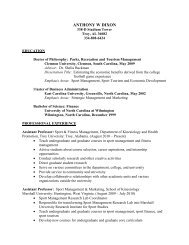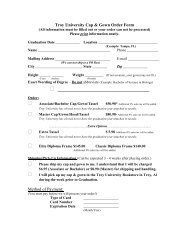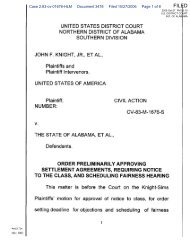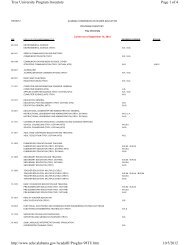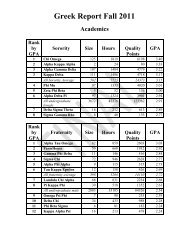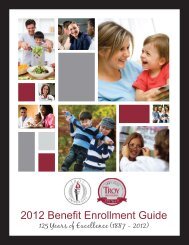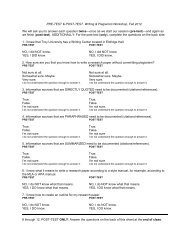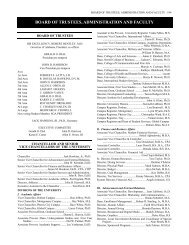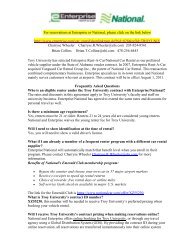A faculty guide to plagiarism - Troy University
A faculty guide to plagiarism - Troy University
A faculty guide to plagiarism - Troy University
- No tags were found...
You also want an ePaper? Increase the reach of your titles
YUMPU automatically turns print PDFs into web optimized ePapers that Google loves.
A <strong>faculty</strong> <strong>guide</strong> <strong>to</strong> <strong>plagiarism</strong>This document is available as part of the <strong>Troy</strong> <strong>University</strong> Libraries Tu<strong>to</strong>rial. The Tu<strong>to</strong>rial can beaccessed online from your TROY Library Web site. This document updated 1/2/09.CONTENTS:About the student <strong>guide</strong>How <strong>to</strong> detect <strong>plagiarism</strong>How <strong>to</strong> help students avoid plagiarizingAbout the student <strong>guide</strong>A Student Guide <strong>to</strong> Plagiarism, available within the Library Tu<strong>to</strong>rial, helps studentsunderstand what <strong>plagiarism</strong> is and how they can avoid plagiarizing. Faculty areencouraged <strong>to</strong> make use of this <strong>guide</strong>—<strong>to</strong> use it as a handout, include it with onlinecourses, etc.How <strong>to</strong> detect <strong>plagiarism</strong>Please note that these are simply suggestions—some <strong>to</strong>ols and methods <strong>to</strong> utilizeand clues <strong>to</strong> look for. They may indicate the possibility of <strong>plagiarism</strong> or some otherscholarship problem, but should be used as part of a larger, more holistic approach.1. Use the university-provided <strong>plagiarism</strong> detection service, TurnItIn.2. Have students write a short paper early in the term so you can compare the writingstyle/level with their later work.3. Look for peculiarities in wording or formatting:o Inconsistent or peculiar formatting (font, color, word case, spacing, anddocumentation style) may indicate that the document was copied and pasted<strong>to</strong>gether from a variety of sources.o British word usage (other than within direct quotes).o Inconsistency in the level of vocabulary.o Inconsistency in verb tense (past, present, future).o Inconsistency in the writer's literary point of view, e.g., their use of I, we, thisauthor, etc.o Obscure or older references that are unlikely for the student <strong>to</strong> have actuallyused. Note: Keep in mind that instead of true <strong>plagiarism</strong>, i.e., literary theft,this could simply be an indication of poor scholarship, e.g., the student isreferencing (using) a primary source discussed in a secondary source without1
properly referencing the secondary source from which they really receivedthe information.4. Consider if the completed assignment is not quite on target. That is <strong>to</strong> say, does itappear as if have they taken a previously created work that was pretty close <strong>to</strong> thecurrent assignment, and tried <strong>to</strong> force-fit it <strong>to</strong> the assignment that was assigned.5. Have students give a class presentation on their assignment, or hold a one-on-onequestion and answer session regarding his or her assignment.6. Ask the student. Tactfully asking a student about their work does not mean you areaccusing them of cheating, just that you are concerned or curious about one or moreaspects of it. If a portion of <strong>plagiarism</strong> is accidental or unintentional, a directapproach may quickly and easily allow you <strong>to</strong> identify the root of your concern, andgive the student an opportunity <strong>to</strong> correct, or at least learn from, their errors.7. Compare the paper <strong>to</strong> the sources. Note: This task will be easier if you requirestudents <strong>to</strong> turn in an electronic copy of their work.8. Ask the student <strong>to</strong> produce drafts, notes, outlines, or other material used <strong>to</strong> developtheir paper. Note: This request is a more reasonable one if you have previouslyinformed your students that they may or will be required <strong>to</strong> do so.9. Ask the student <strong>to</strong> produce their sources—print or electronic copies of journalarticles or Web sites, or direct you <strong>to</strong> the library or database from which theyobtained books. Note: This request is a more reasonable one if you have previouslyinformed your students that they may or will be required <strong>to</strong> do so.How <strong>to</strong> help students avoid plagiarizingThe following is not a formal how-<strong>to</strong> <strong>guide</strong>, but is a broad spectrum of suggestionsand ideas <strong>to</strong> assist <strong>faculty</strong> and administra<strong>to</strong>rs in dealing with issues of <strong>plagiarism</strong>.Administra<strong>to</strong>rs should make their <strong>faculty</strong> aware of institutional policies and procedures, andregional or departmental <strong>guide</strong>lines regarding <strong>plagiarism</strong>. It is of paramount importance that<strong>faculty</strong> handle <strong>plagiarism</strong> issues in a proper and uniform manner, both for their sake and tha<strong>to</strong>f the institution, as well that of the student.1. Faculty and administra<strong>to</strong>rs need <strong>to</strong> know what <strong>plagiarism</strong> really is (and is not). Whilethe publication A Student Guide <strong>to</strong> Plagiarism provides sound <strong>guide</strong>lines for defining<strong>plagiarism</strong>, individual persons and institutions will vary in how they choose <strong>to</strong> define<strong>plagiarism</strong>, or differentiate among certain aspects thereof.2. Faculty should make students aware of what <strong>plagiarism</strong> is and how they can avoidplagiarizing. Providing them with the publication A Student Guide <strong>to</strong> Plagiarism is oneway <strong>to</strong> accomplish that goal.3. Let students know why <strong>plagiarism</strong> is an important issue.2
4. Take the time <strong>to</strong> discuss and promote student responsibility; codes of conduct;academic integrity, honesty, and trust. Conduct your academic affairs in a mannerwhich exemplifies and promotes these ideals.5. Present a positive attitude when discussing <strong>plagiarism</strong> with your students. Make itclear that you are not out <strong>to</strong> get them, but rather <strong>to</strong> educate them. Remind yourstudents that taking the time <strong>to</strong> address the subject will:o Help them <strong>to</strong> avoid plagiarizing.o Assist them in developing their research, writing, and critical thinking skills.o Improve their academic performance, both in terms of the grades theyreceive and by what they actually learn and retain.o Strengthen the value of their degree by supporting and enforcing theStandards of Conduct of troy.6. Know the reasons, intentional and unintentional, why students plagiarize.o Read point #1 of Anti-<strong>plagiarism</strong> Strategies for Research Papersohttp://www.virtualsalt.com/antiplag.htm.Read the section “Current State of Cheating” from “Kimbel Library:Presentations: Cheating 101: Paper Mills and You”http://www.coastal.edu/library/presentations/papermil.html.7. Use your syllabus or other course materials <strong>to</strong> let your students know your policy on<strong>plagiarism</strong>, including specific penalties.8. Have a clear policy regarding recycling or dual publication, i.e., when, if ever, do youallow it.ooRecycling defined: As stated in A Student Guide <strong>to</strong> Plagiarism, “Another type ofself-<strong>plagiarism</strong>: A student reusing their own paper, or a modified versionthereof, without permission of the instruc<strong>to</strong>r(s). This could mean recycling apaper they previously turned in, or writing one paper <strong>to</strong> satisfy therequirements of two concurrent assignments. Whereas some definitions of<strong>plagiarism</strong> would not apply here, since the student is not representingsomeone else's work as their own, many instruc<strong>to</strong>rs and institutions maychoose <strong>to</strong> classify such actions as <strong>plagiarism</strong>. In any case, unauthorizedrecycling or dual publication is an act of dishonesty and is alwaysunacceptable.”If you do allow a student <strong>to</strong> satisfy two concurrent assignments (yours andanother instruc<strong>to</strong>r's) with one paper, presentation, or project, never do sowithout the approval of the other instruc<strong>to</strong>r.9. Assignments and <strong>to</strong>pics.oooGive assignments that interest the student, either by choice from a pool of<strong>to</strong>pics, or by instruc<strong>to</strong>r approval. If the students are interested in the <strong>to</strong>pic,they will be more inclined <strong>to</strong> do quality research and writing.Research assignments should be designed <strong>to</strong> reduce the likelihood that thestudent can find, purchase, modify, or recycle a previously created work <strong>to</strong>fulfill the assignment.Make assignments that are unique and specific.3
o When possible, make the assignment, or a portion thereof, local or regional,or related <strong>to</strong> the student in a personal way.o "As part of the paper or as a separate assignment, have students reflectpersonally on the <strong>to</strong>pic they are writing on or on the process of doingresearch and writing." (Quote from Kimbel Library,http://www.coastal.edu/library/presentations/easystep.html)o Change or rotate assignments/<strong>to</strong>pics on a regular basis, and keep them up<strong>to</strong>-date.o Set clear <strong>guide</strong>lines and approval procedures for studentsselecting/modifying their own <strong>to</strong>pics.o Have students apply classroom instruction, discussion, or readings <strong>to</strong> theirassignment.o Make assignments that require critical thinking and synthesis, not just arehashing of facts or a presentation of someone else's ideas.10. Research and reporting.o Make your students aware of the resources available <strong>to</strong> them. <strong>Troy</strong> <strong>University</strong>provides a wealth of library materials and personal assistance.o Require students <strong>to</strong> turn material in as their paper develops, e.g., the thesisstatement, an outline, notes, a list of sources, drafts, a list of research <strong>to</strong>olsthey used (databases, libraries, etc.) and the dates they used them.o Let students know that they may, or will, be required <strong>to</strong> produce or turn intheir sources, e.g., print or electronic copies of journal articles or Web sites,and the name of the library or database from which print or electronic bookswere obtained.o Provide sample(s) of what you consider <strong>to</strong> be a good paper, both in terms ofcontent and style. Note that you can provide this online through the <strong>Troy</strong><strong>University</strong> Library's electronic reserve service.o Make it clear how you want papers formatted. Use a standard format, e.g.,American Psychological Association, Modern Language Association, orTurabian. Spell out the name of the style you want followed and name bookthat prescribes that source—don't take for granted that students know whatis meant by APA, MLA, or Turabian. Similarly, encourage them <strong>to</strong> purchaseand retain the proper book:• For APA: Publication Manual of the American Psychological Association,Fifth Edition.• For MLA: MLA Handbook for Writers of Research Papers, Sixth Edition.• For Turabian: Manual for Writers of Term Papers, Theses, and Dissertations,Seventh Edition.• Citing electronic resources, e.g., online databases or Internet sites, isoften a difficult process which is covered only briefly in theaforementioned <strong>guide</strong>s. Therefore, <strong>to</strong> assist you in this process, theLibrary provides a formal <strong>guide</strong>, Citing the World Wide Web in Style. It is4
ooooavailable online from the <strong>Troy</strong> <strong>University</strong> Libraries Tu<strong>to</strong>rial for Students,Faculty, and Staff.When possible, require/emphasize the use of current references. To clarifythis point: Requiring at least a portion of the sources <strong>to</strong> be current, willreduce the student's ability <strong>to</strong> use (plagiarize) a previously-created work <strong>to</strong>fulfill their assignment.Make specific resource-type requirements, <strong>guide</strong>lines, or recommendations.For example: No more than X number or percentage of material from theInternet, at least a specified amount from journals, requirements regardingthe level or amount of scholarly/peer-review/refereed articles, print orelectronic books.Ask students <strong>to</strong> annotate their sources. This could include a brief summaryor description of the source, its reliability, suitability, a comparison with othersources, etc.Have students provide a record of their research. What libraries did they useand did they request/receive assistance? What thesauri or other research<strong>to</strong>ols did they use? What human resources (instruc<strong>to</strong>rs/peers/librarians) didthey use <strong>to</strong> develop their search terms and strategies? What catalogs,databases, and search engines did they use? Which of those resources yieldedgood results and which were dead ends? What terms did they search on …which ones were productive and which ones yielded poor results? What werethe dates and times spent on their work? What research or writing skills dothey think they most need <strong>to</strong> improve?11. Set deadlines and put in writing penalties for exceeding them.12. Have a written policy regarding, and procedure for requesting an extension ofdeadlines.13. Use the <strong>University</strong>-provided <strong>plagiarism</strong> service, TurnItIn, and encourage yourcolleagues <strong>to</strong> do so.14. For assignments that take the form of a written paper or notes for a verbal or audiovisualpresentation, require students <strong>to</strong> turn in not only their printed report, but alsoan electronic copy. To clarify this point: This will help students avoid <strong>plagiarism</strong> ifyou let them know that you will use the electronic copy <strong>to</strong> assist you in <strong>plagiarism</strong>detection, should it be necessary.15. Help students learn from their mistakes.ooAsk/allow them <strong>to</strong> correct their graded papers, revise their presentationsnotes/materials, etc.When grading papers, projects, presentations, or other assignments, bespecific in your evaluation. Differentiate (and specify) your grading forgrammar, style, content, etc., and make suggestions for improvement.5



